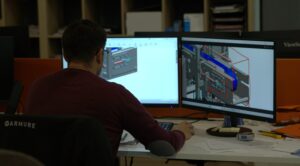Artificial intelligence (AI) is no longer a futuristic promise but a practical tool that transforms the user experience (UX). From automating repetitive tasks to creating personalized experiences, AI is redefining the way people interact with digital products.
In this article, we explore how AI is integrated into UX design and what impact it has on the evolution of modern interfaces.
Intelligent chatbots: beyond the basic assistant
One of the first points of contact between AI and UX design has been chatbots. Initially designed as basic assistants capable of answering frequently asked questions, today’s chatbots, thanks to natural language processing (NLP), can hold more human conversations, understand user intent and solve complex problems.
Platforms such as ChatGPT, Google Dialogflow or IBM Watson allow the design of conversational assistants that not only respond, but also learn from user behavior to continuously improve. This translates into reduced waiting time, improved customer service and a better user experience, a smoother and more personalized one.
Data-driven personalization: Adaptive UX
AI makes it possible to analyze large volumes of data in real time, which offers the possibility of adapting interfaces to the needs and behaviors of each user. This customization goes beyond recommending products: you can modify menus, highlight functionalities or redesign the navigation flow according to the user’s profile.
Examples such as Netflix or Spotify demonstrate how a well-designed recommendation system can dramatically improve user retention. In UX design, this translates into experiences that seem tailor-made, generating greater satisfaction and engagement.
Predictive interfaces: anticipating the user
Another of the most powerful applications of AI in UX design are predictive interfaces. These not only react to user actions, but are able to anticipate their needs. Based on machine learning, these interfaces can suggest actions, autocomplete forms, anticipate errors or even reorganize content to optimize the experience.
A clear example is Google Maps, which adapts routes and suggestions in real time based on navigation history, traffic patterns and user behavior. This proactive approach reduces cognitive load and improves efficiency, two fundamental pillars of good UX design.
New ethical and design challenges
Despite the advantages, the integration of AI into UX poses significant challenges. Over-personalization can generate an information “bubble” that limits user exposure to new content. In addition, biases in training data can be reproduced in AI systems, negatively affecting the experience of certain users.
From the design point of view, it is essential to ensure transparency (for example, by warning when interacting with an AI), control (allowing users to modify their preferences) and inclusion (designing systems that are accessible to all profiles). AI should not replace design empathy, but enhance it.
In conclusion, we can state that AI is broadening the horizons of product design in general and UX design in particular, by enabling more intelligent, adaptive and user-centered experiences. However, its implementation must be accompanied by ethical reflection and a people-centric approach. In the hands of aware and well-informed designers, AI can be a key ally in building truly meaningful digital products.
At i-mas, our passion for UX/UI drives us to keep researching, iterating and improving on every project to ensure that what we create meets our clients’ expectations and delivers a unique and memorable experience.
If you are interested in learning more about our services or have a project in mind, do not hesitate to contact us!



